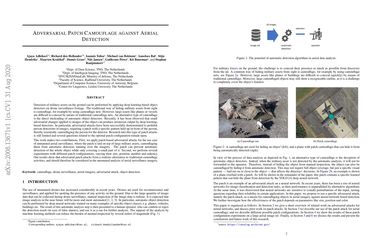Adversarial Patch Camouflage against Aerial Detection
Detection of military assets on the ground can be performed by applying deep learning-based object detectors on drone surveillance footage. The traditional way of hiding military assets from sight is camouflage, for example by using camouflage nets. However, large assets like planes or vessels are difficult to conceal by means of traditional camouflage nets. An alternative type of camouflage is the direct misleading of automatic object detectors. Recently, it has been observed that small adversarial changes applied to images of the object can produce erroneous output by deep learning-based detectors. In particular, adversarial attacks have been successfully demonstrated to prohibit person detections in images, requiring a patch with a specific pattern held up in front of the person, thereby essentially camouflaging the person for the detector. Research into this type of patch attacks is still limited and several questions related to the optimal patch configuration remain open. This work makes two contributions. First, we apply patch-based adversarial attacks for the use case of unmanned aerial surveillance, where the patch is laid on top of large military assets, camouflaging them from automatic detectors running over the imagery. The patch can prevent automatic detection of the whole object while only covering a small part of it. Second, we perform several experiments with different patch configurations, varying their size, position, number and saliency. Our results show that adversarial patch attacks form a realistic alternative to traditional camouflage activities, and should therefore be considered in the automated analysis of aerial surveillance imagery.
PDF Abstract
